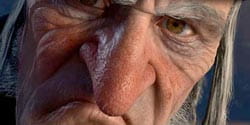By Mark D. Roberts
 If I were to tell you that Charles Dickens wrote a story about a solitary, crotchety old man who despised both people and Christmas until some supernatural visitors came to him on Christmas Eve and taught him to have a new perspective on life, you'd probably yawn and say, "Yes, of course, Ebenezer Scrooge." But if I were to tell you I wasn't thinking of Ebenezer Scrooge at all, but rather of Gabriel Grub, you might be a bit surprised. So go ahead and be surprised, if you wish, because what I'm saying is true.
If I were to tell you that Charles Dickens wrote a story about a solitary, crotchety old man who despised both people and Christmas until some supernatural visitors came to him on Christmas Eve and taught him to have a new perspective on life, you'd probably yawn and say, "Yes, of course, Ebenezer Scrooge." But if I were to tell you I wasn't thinking of Ebenezer Scrooge at all, but rather of Gabriel Grub, you might be a bit surprised. So go ahead and be surprised, if you wish, because what I'm saying is true.
In 1836, seven years before he wrote A Christmas Carol, Dickens published a short story as Chapter 29 of The Pickwick Papers. "The Story of the Goblins who stole a Sexton" narrates the strange experiences of Gabriel Grub, the sexton (caretaker and gravedigger) for a church in a rural village, and a literary cousin of Ebenezer Scrooge. According to Dickens, Gabriel Grub was "an ill-conditioned, cross-grained, surly fellow -- a morose and lonely man, who consorted with nobody but himself." He had "a deep scowl of malice and ill-humor." Sounds like Scrooge, doesn't he?
One Christmas Eve Grub decided to go to the churchyard to dig a grave. As he walked through the streets of his village, he watched people making preparations for Christmas parties -- parties he wouldn't even think to attend, should he have been invited. When he saw children playing games, Grub amused himself with the thought of "measles, scarlet fever, thrush, whooping-cough, and a good many other sources of consolations besides." If his neighbors offered him a Christmas greeting, Grub returned "a short, sullen growl," not "Humbug!" but its preverbal precursor. When a young lad was singing a Christmas song in the street, Gabriel Grub cornered the boy and "rapped him over the head with his lantern five or six times." As he began digging a grave, Grub cheered himself with this thought: "A coffin at Christmas! A Christmas box! Ho! ho! ho!"
But then Gabriel Grub received a surprise visitor, a grinning goblin who taunted him with clever dialogue. Soon this goblin was joined by "a whole troop of goblins" who captured Grub and dragged him down into the earth. Grub found himself in a cavern with the first goblin, the "king of goblins," and his band. They proceeded to show him a series of scenes that were magically projected in the end of the cavern. The first scene was of a poor family: many children and their mother. The children rejoiced when their father joined them. But then the scene shifted to a bedroom, in which "the fairest and youngest child lay dying." "Even as the sexton looked upon him with an interest he had never felt or known before, the little boy died." Yet the family had assurance that their little one was in "happy Heaven." (The similarity between this scene and that of Bob Cratchit's family in A Christmas Carol is striking.)
After the magic scene was finished, the goblins beat Gabriel Grub, and then showed him another ghostly video. This sequence of viewings and beatings happened many times over, and "many a lesson it taught to Gabriel Grub." "He saw that men who worked hard, and earned their scanty bread with lives of labor, were cheerful and happy . . . because they bore within their own bosoms the materials of happiness, contentment, and peace." On the other hand, Gabriel Grub "saw that men like himself, who snarled at the mirth and cheerfulness of others, were the foulest weeds on the fair surface of the earth, and setting all the good of the world against the evil, he came to the conclusion that it was a very decent and respectable sort of world after all." At this point he fell asleep, only to awake in the churchyard on Christmas morning.
Grub "was an altered man." Yet "he could not bear the thought of returning to a place where his repentance would be scoffed at, and his reformation disbelieved." So Gabriel Grub disappeared from his village for ten years. When he finally returned, he was "a ragged, contented, rheumatic old man." The moral of the story, according to the narrator, was "that if a man turn sulky and drink by himself at Christmas time, he may make up his mind to be not a bit the better for it: let the spirits be never so good."
Reading the story of Gabriel Grub is like looking at the charcoal sketches of an artist getting ready to paint a masterpiece. The parallels between "The Story of the Goblins" and A Christmas Carol are obvious: a solitary, nasty old man not only refuses to celebrate Christmas, but also spurns the greetings of those who do, and even tries to hurt a boy who sings a Christmas carol. On Christmas Eve this man receives unexpected supernatural visitors who proceed to show him many scenes of life, including a moving scene of a poor, loving family whose youngest child is terribly ill. In the end the man is changed by this experience.




